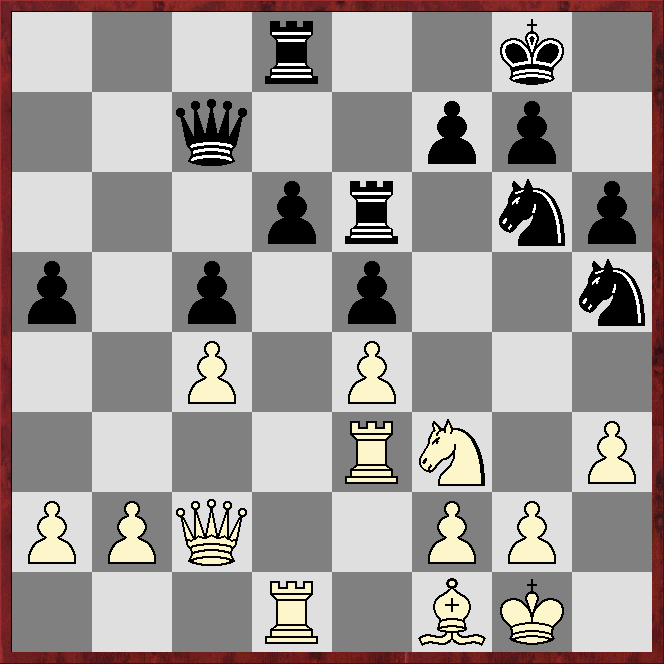What he did not know is that I have played in the Czech city 10 times before, which got me to thinking about how I have performed there.
Here are my results.
YEAR...RATING...SCORE... PERFORMANCE
2009......2020.........+4=2-3.....1923 (-97)
2010......2057.........+4=1-4.....2009 (-46)
2011......1999.........+4=0-5.....1876 (-123)
2014......1976.........+3=4-2.....1826 (-150)
2015......1950.........+5=0-4.....1962 (+12)
2016..... 1923.........+5=1-3.....1988 (+65)
2017......1836.........+5=2-2.....1971 (+135)
2018......1946.........+4=4-1.....2021 (+75)
2019......1881.........+4=3-2.....1905 (+24)
2022......1852.........+4=1-4.....1737 (-115)
Overall I have scored +42=18-30, or 56.7%. My average rating was 1944 and my average performance was 1922 (-22).
I generally have fond memories of Olomouc, which I guess may be connected to my winning percentage rather than my average performance.
Hunting for highlights, it seemed to make sense to first look at 2017, where I played three English players in consecutive rounds.
I drew with Joe Skielnik and lost to Paul Stokes, with the following game sandwiched in-between.
Ian Heppell (2062) - Spanton (1836)
Reversed Philidor?
1.e4 e5 2.Nf3 Nc6 3.d3!?
I am fairly sure I did not realise White is angling for a Philidor Defence, but with colours reversed and an extra tempo.
*****
*****
*****
*****
3...Nf6
Viktor Bologan in Bologan's Black Weapons In The Open Games (New In Chess 2014) recommends 3...d5!?, which is not at all popular, perhaps because, whatever its merits, it gives White a central structure familiar, with colours reversed, from the Philidor.
4.Be2 Bc5 5.0-0 d6 6.c3
The position is arguably more reminiscent of a Reversed Pribyl than a Reversed Philidor, except in the real Pribyl White will have played e4 and d4 (e5 and d5 here), while in the real Philidor White will not always play an early d4.
6...a5
James Hanham, of Philidor Defence fame, had the position after 6.c3 with white at least twice, his opponents playing 6...Bb6.
7.d4 Bb6 8.d5 Ne7 9.Na3 0-0
Not 9...Nxe4?? 10.Qa4+ etc.
10.Qc2 c6 11.dxc6 bxc6 12.Nc4 Ba6 13.Bg5
IH said afterwards he should have gone for the slight edge that comes with 13.Nxb6. Stockfish16 and Komodo14.1 agree, but only marginally.
13...Bxc4 14.Bxc4 Ng6 15.Rad1 h6 16.Bc1
IH had hoped to play 16.Nh4? hxg5 17.Nxg6 but saw in time that after 17...Re8 the knight would be trapped.
16...Qc7 17.Rfe1 Rad8 18.h3 Nh5 19.Bf1!? Rfe8 20.c4!?
This was presumably the main idea behind 19.Bf1!? The d pawn is fixed as semi-backward for the foreseeable future, but the light-square bishop becomes a miserable-looking piece.
This was presumably the main idea behind 19.Bf1!? The d pawn is fixed as semi-backward for the foreseeable future, but the light-square bishop becomes a miserable-looking piece.
20...Re6 21.Be3!? Bxe3 22.Rxe3 c5!?
 |
| The d pawn is now fully backward, but Black can hope to get a knight into d4, and meanwhile the bishop has few offensive prospects |
*****
*****
*****
*****
23.Ra3 Ne7 24.Qd2
IH offered a draw.
24...Nc6 25.g3 Kh7 26.Kh2 Ra8 27.Be2 g6 28.Rd3 Rd8 29.Kg2 Nf6 30.Qe3?!
Probably better is 30.Re3, but the engines give Black the upper hand.
30...Nb4 31.R3d2 Nxa2 32.Nh2 Nb4 33.Ng4 Nxg4 34.hxg4 Kg7 35.Rh1 g5
*****
*****
*****
*****
36.f4?!
Trying to open lines in the hope of getting at the black king, before Black's advantages tell, but the engines reckon it was probably better to sit tight and wait for Black to try to make progress.
36...f6
The engines prefer double-capturing on f4.
37.Rdd1
The engines suggest 37.f5, effectively meaning any action has to take place on the queenside.
37...Nc2 38.Qf2
The engines reckon 38.Qd2 and 38.Qd3 are better.
38...Nd4
Also strong is 38...exf4.
39.Bf3 Qb7 40.Rd2 Qb4 41.Rc1? 0-1
IH resigned rather than waiting for 41...Nb3.


No comments:
Post a Comment